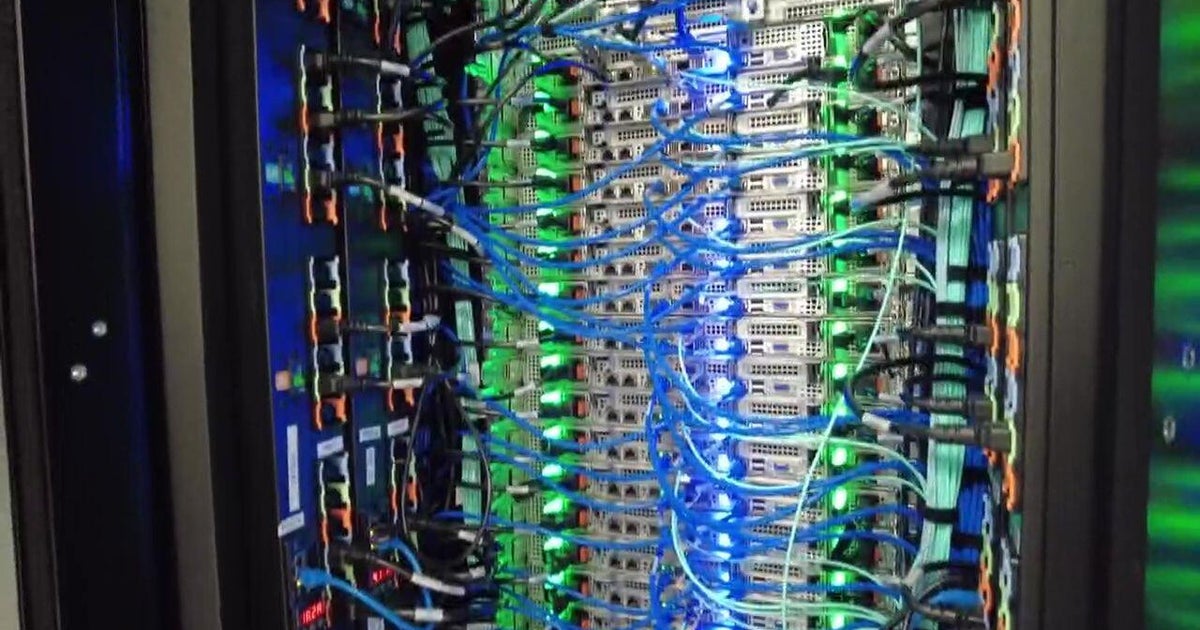New Jersey residents have been complaining about out-of-control utility bills. The board that regulates electric and gas service in the state says artificial intelligence is helping drive up some of those costs.
A report by the Berkeley Lab estimates the power usage of data centers more than doubled between 2017 and 2023, largely due to the growth in AI servers.
However, officials at those centers argue it’s not just their sites stressing the power system.
The importance of data centers
Outside of DataBank, a data center in Piscataway, there is a constant hum of cooling systems, transformers and a mini power substation, all keeping thousands of people connected to the digital world.
“We have government entities. We have AI providers. We have hospitals. We have research firms,” said Dan Fuentes, senior vice president of sales.

Back-up systems and caged servers belonging to companies renting space at a secure facility, owned by DataBank.
CBS News New York
Inside, there are back-up systems and caged servers belonging to companies renting space at the secure facility, owned by DataBank. CBS News New York was given a tour of its maze of machinery.
“You hear it is very loud in here,” solution architect Michael Alvaro said. “Without those cool units on, we’ll overheat this system in a matter of seconds.”
These types of data centers handle our financial transactions and host our photos and videos and the shows that we stream online.
“So, whenever you request some sort of information on a phone, it goes to a physical building, that company houses that data and information,” Fuentes said.
Databank has 64 other facilities across the U.S., including one in New York.
The New Jersey Institute of Technology says the Piscatawsy site is important for its AI applications that need to stay cool.
“Different types of computational modeling — weather simulation, material development like battery design,” said Kate Cahill, NJIT’s director of high-performance research computing.
AI-driven data centers hoard electricity
Christine Guhl-Sadovy, the president of the New Jersey Board of Public Utilities, said data centers — some 5,000 nationwide — come with a price to utility customers.
“AI-driven data centers [are] very important to national security. They do a lot of really incredible things. ChatGPT is one of them,” Guhl-Sadovy said. “But they also use a tremendous amount of electricity and electricity is a commodity, so as we have a shorter supply, the price goes up, and so, that is really the driving factor for these increases in electricity bills.”
“Data centers are obviously contributing to that supply-demand dynamic, but we certainly are not the only ones,” DataBank CEO Raul Martynek said.
Martynek said an aging power system and semiconductor research strengthened by the CHIPS Act are also contributing factors.
“It’s about all this technology that humans have and humans love to use and continue to want to use and that’s what’s driving the demand,” Martynek said.
“We need more electricity generation”
CBS News New York spoke to Tom Wilson, the principal technical executive at the Electric Power Research Institute, about the power grid.
“A lot of our system was expanded in the 1950s, 60s and 70s, and so you are looking at a system that is quite old and needs to be replaced in many cases,” Wilson said.
Asked what the solution is to rising utility bills, Wilson said, “The big thing is we need more electricity generation. The fastest way to do that, if you care about the environment and you want to make sure electricity is coming from clean resources, really is solar and battery storage.”
The NJBPU’s Guhl-Sadovy acknowledges that nuclear power plants, including many closing across the state, are also solutions. However, with the boom in AI, data centers are expected to more than triple by 2028.
All sides agree that making the centers more efficient is crucial for the future.
